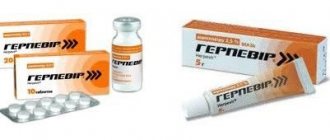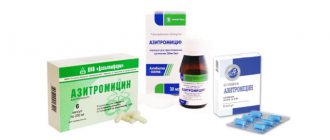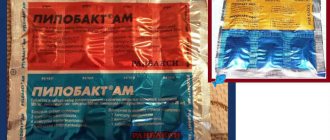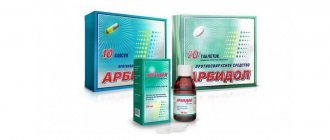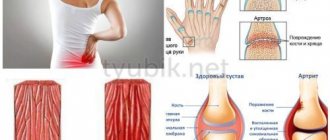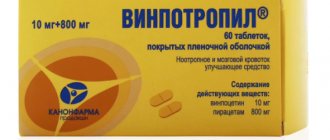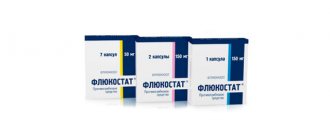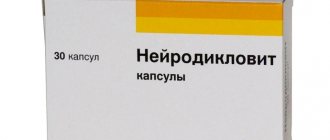Release form and composition
The drug is released in the following forms:
- tablets: flat-cylindrical, with a score and a chamfer, white (10 pcs. in a contour pack, 1, 2 or 3 packs in a cardboard pack; 20 pcs. in glass jars, 1 jar in a cardboard pack);
- ointment for external use: white or white with a yellow tint (5 g in aluminum tubes, 1 tube in a cardboard box).
1 tablet of Acyclovir-AKOS contains:
- active ingredient: acyclovir – 200 mg;
- additional components: potato starch, talc, magnesium stearate.
1 g of Acyclovir-AKOS ointment contains:
- active ingredient: acyclovir – 50 mg;
- additional components: 1,2-propylene glycol, lipocomp (lipid component of poultry fat) or chicken oil, polyethylene oxide-400, emulsifier No. 1, nipazole, nipagin, purified water.
Pharmacological properties
Pharmacodynamics
Acyclovir is an antiviral (antiherpetic) agent that is a synthetic analogue of a purine nucleoside that has the ability to suppress in vitro and in vivo replication of Herpes simplex viruses type 1 and 2, Epstein-Barr virus, Varicella zoster virus and cytomegalovirus.
Acyclovir-AKOS demonstrates high activity against Herpes simplex viruses types 1 and 2; the virus that causes shingles and chickenpox - varicella zoster; Epstein-Barr virus [virus types are arranged in increasing order of the minimum inhibitory concentration (MIC) of the active substance]. It also shows a moderate effect against cytomegalovirus.
In infected cells, which include the enzyme thymidine kinase synthesized by viruses, phosphorylation and transformation of acyclovir into acyclovir monophosphate occurs. Subsequently, under the action of acyclovir guanylate cyclase, monophosphate is converted into diphosphate and, under the influence of several cellular enzymes, into triphosphate. The drug is characterized by high selectivity of action specifically on viruses and low toxicity towards humans, due to the fact that acyclovir is not a substrate for thymidine kinase of uninfected cells, and as a result is low toxic to mammalian cells.
Acyclovir triphosphate blocks the replication (synthesis) of viral DNA through the following mechanisms:
- Competitively replaces deoxyguanosine triphosphate during DNA synthesis.
- By integrating into the DNA chain being synthesized, it terminates it.
- Suppresses the activity of viral DNA polymerase.
As a result of the effect exhibited by acyclovir, the virus stops reproducing in the body. The specificity and high selectivity of the drug’s action are also due to its predominant accumulation in virus-infected cells. Against the background of herpetic infection, the drug prevents the appearance of new elements of the rash, reduces the risk of visceral complications and skin dissemination, accelerates the formation of crusts, and reduces pain in the acute stage of herpes zoster. The drug has an immunostimulating effect.
Pharmacokinetics
After oral administration, acyclovir is partially absorbed in the intestine. Due to low lipophilicity, after oral administration of 200 mg of the drug, absorption averages 20% (from 15 to 30%), but at the same time dose-dependent concentrations are formed, required for effective treatment of viral lesions. Food intake does not have a significant effect on the absorption of acyclovir. As the dose increases, the bioavailability of the drug decreases.
When used orally 5 times a day, 200 mg, the maximum concentration (Cmax) of the drug is 0.0007 mg/ml, the minimum (Cmin) is 0.0004 mg/ml, the time to reach Cmax is 1.5–2 hours. Plasma protein binding is low – 9–33%.
The active substance passes through the blood-brain barrier and also penetrates well into tissues and organs such as the liver, lungs, kidneys, brain, tear fluid, aqueous humor, intestines, spleen, muscles, mucous membrane and vaginal secretions, uterus, breast milk, sperm , contents of herpetic vesicles. The concentration of acyclovir in the cerebrospinal fluid is 50% of that in the blood. Acyclovir-AKOS penetrates the placenta and is excreted in small quantities in breast milk. After a daily dose of 1000 mg, divided into 5 doses, acyclovir is detected in breast milk in concentrations equivalent to 0.6–4.1% of its plasma concentrations (the substance can enter the child’s body with mother’s milk at a dose below 0.3 mg /kg/day).
Metabolic transformation occurs in the liver with the formation of the metabolite 9-carboxymethoxymethylguanine. The drug is excreted by the kidneys through tubular secretion and glomerular filtration. When taken orally, approximately 62–91% of the dose is excreted unchanged and about 14% is excreted in the form of a metabolite. Less than 2% is excreted through the digestive tract; trace amounts are detected in exhaled air.
When conducting a single hemodialysis session over 6 hours, the plasma concentration of acyclovir is reduced by approximately 60%; with peritoneal dialysis there is no significant change in the clearance of acyclovir. The half-life (T½) when taking the drug orally is 3.3 hours in adults and 2.6 hours in children and adolescents from 1 year to 18 years. With age, the rate of excretion decreases, but at the same time T1/2 of the active substance increases slightly.
In the presence of severe chronic renal failure, T1/2 does not exceed 20 hours. In adult patients with renal failure, T1/2 depends on creatinine clearance (CC): with a creatinine clearance of 15–50 ml/min it is 3.5 hours, at 50–80 ml/min – 3 hours, at 80 ml/min – 2 ,5 hours. In patients with anuria, T1/2 of the drug is 19.5 hours, during a hemodialysis session – 5.7 hours, against the background of continuous outpatient peritoneal dialysis – 14–18 hours.
In the case of combined use of acyclovir and zidovudine in HIV-infected patients, the pharmacokinetic parameters of both drugs remain practically unchanged.
When applying the ointment to intact skin, minimal absorption is observed, and to the affected skin – moderate absorption. The active substance is not detectable in blood and urine when applied externally.
A drug
In what dose is the medication “Acyclovir-Acos” prescribed? Instructions for using these tablets will be presented below. You will also learn about what this product is used for, whether it has side effects and contraindications, what is included in its composition, and in what packaging it is sold.
Composition, description, packaging of the medicinal product
What components does Acyclovir-Acos (tablets) contain? The instructions for use state that the active component of this medicine is acyclovir. It also contains additional ingredients in the form of talc, magnesium stearate and potato starch.
"Acyclovir-Akos" - tablets (patient reviews will be described below) are flat-cylindrical, white, with a score and a chamfer. The drug goes on sale in contour cells, which are placed in cardboard packages. This medicine can also be found in dark glass jars.
Pharmacological properties of the drug
How does Acyclovir-Acos (tablets) work? The instructions for use state that this is an antiherpetic antiviral agent. This drug is a synthetic analogue of purine nucleoside. It is capable of inhibiting the replication of herpes simplex viruses, cytomegalovirus, as well as Epstein-Barr and Varicella zoster viruses.
Features of the drug
According to experts, Acyclovir-Acos, reviews of which are mostly positive, shows good activity against viruses that cause shingles and chickenpox.
After taking the drug, phosphorylation begins in infected cells. Acyclovir is converted to acyclovir monophosphate. Under the influence of guanylate cyclase, the latter is converted into diphosphate, which, in turn, is converted into triphosphate.
The selective effect of the drug on viruses, as well as its low toxicity to the body, is due to the fact that its active substance is not a substrate for the enzyme thymidine kinase. Therefore, it is not toxic to mammalian cells.
After converting acyclovir to acyclovir triphosphate, it inhibits viral DNA synthesis by 3 mechanisms:
- replaces deoxyguanosine triphosphate;
- integrates into the DNA chain and then stops its elongation;
- has a depressing effect on the DNA of herpes simplex, etc.
As a result of this effect, the virus stops reproducing.
The effectiveness of acyclovir is also due to its accumulation in cells that are already affected by the virus. For herpes, the drug prevents the formation of new rashes, and also accelerates the healing of wounds, reduces pain and has an immunostimulating effect.
Pharmacokinetic parameters of antiherpetic tablets
Where is the absorption of the drug "Acyclovir-Acos"? The instructions for use indicate that after oral administration it is absorbed in small quantities from the intestines. In this case, such concentrations (dose-dependent) are formed that are quite sufficient for the effective treatment of viral diseases.
Food has virtually no effect on the absorption of the active substance. As the dose increases, the bioavailability of the drug decreases.
The maximum concentration of the drug after its administration orally in the amount of 200 mg 5 times a day is 0.75 mcg/ml, and the minimum is 0.45 mcg/ml. These values are noted after two hours.
The active substance binds to plasma proteins by 10-35%.
Metabolism of the drug occurs in the liver. This produces a metabolite called 9-carboxymethoxymethylguanine.
The medication is excreted through the kidneys (62-91% of the dose taken) and through the gastrointestinal tract. Also, trace amounts of the drug are determined in the air exhaled by the patient.
When the drug is taken orally, its half-life (in adults) is 3.4 hours, and in children (1-18 years old) – 2.4 hours. Thus, we can safely note that the rate of elimination of the drug slows down with age.
Indications for use of the drug
When is Acyclovir-Acos prescribed? The use of this drug is indicated for the prevention and treatment of infections caused by the Varicella zoster and Herpes simplex viruses (types 2 and 1). Thus, this medication effectively combats:
- herpes simplex on the skin and mucous membranes (recurrent and primary);
- herpes zoster;
- genital herpes (primary and recurrent);
- herpes zoster;
- chickenpox (on the first day after the rash appears).
It should also be noted that this drug is actively prescribed to patients with severe immunodeficiency (for example, in HIV-infected people, after transplantation and while taking immunosuppressive medications).
Contraindications for use
In what cases is it prohibited to use Acyclovir-Acos (tablets)? The instructions indicate the following contraindications:
- children's age (up to three years);
- hypersensitivity to the active substance, as well as to valacyclovir.
This medication is prescribed with extreme caution during pregnancy, renal failure and dehydration, as well as during breastfeeding.
The drug "Acyclovir-Acos": how to take for adults?
The tablets should be taken orally, regardless of food, with a glass of plain water.
For the treatment of herpes simplex on the mucous membranes and skin, adults are prescribed 200 mg of the drug five times a day. The medicine should be taken every four hours (excluding sleep).
Typically, the duration of therapy with this drug is five days. But if necessary, it can be extended (according to the doctor’s recommendations).
When treating people with immunodeficiency, the single dosage of the drug is increased to 400 mg, and the course duration is increased to ten days or more.
Adult patients with genital herpes are recommended to take 200 mg of the drug five times a day (every four hours) for 10 days (if necessary, therapy can be extended). Treatment should begin as soon as possible after the first signs of infection appear. If relapses occur, the drug is prescribed already in the prodromal period.
To prevent relapses of infections caused by the herpes simplex virus, the medication is prescribed 200 mg four times a day (every six hours). People with normal immunity can use the drug in an amount of 400 mg twice a day (every 12 hours). In case of severe immunodeficiency, the dosage remains the same, but the frequency increases to five times a day.
Recurrent genital herpes (less than six times a year) requires the following treatment regimen: 200 mg five times a day for five days. If episodes recur more than six times a year, the patient is prescribed 400 mg of the drug twice a day for 12 months. The duration of prophylaxis is usually determined by the length of the period when there is a risk of infection.
The maximum single dosage of this medication is 800 mg.
People taking higher doses of the medicine should receive plenty of fluids.
"Acyclovir-Akos" (tablets): instructions for children
For children over three years of age, this medication should be prescribed only by experienced pediatricians. As a rule, their dosages are similar to those for adults.
To treat chickenpox, children over six years old are given 800 mg of the drug four times a day, and a child aged 3-6 years is given 400 mg four times a day. For a more accurate dosage, doctors use the following formula: 20 mg for every kg of baby’s weight. Taking more than 800 mg of medication four times a day is prohibited.
The duration of therapy in young patients is five days.
In people with impaired renal function, dose adjustment, as well as frequency of administration, is required. This depends on the type of infection and the amount of creatinine clearance.
Side effects after taking the pills
The drug "Acyclovir-Acos" very rarely causes side effects. But, according to the instructions, they still take place.
- Nausea, increased bilirubin levels, diarrhea, abdominal pain, vomiting, reversible increase in liver enzyme activity.
- Acute renal failure, increased levels of creatinine in the blood and urea.
- Leukopenia, anemia, thrombocytopenia.
- Headache, hallucinations, reversible neurological disorders, confusion, dizziness, paresthesia, drowsiness, coma, convulsions.
- Rash, shortness of breath, photosensitivity, angioedema, urticaria, fever, itching, lymphadenopathy, anaphylaxis, agitation, blurred vision, peripheral edema, myalgia.
- Fatigue, alopecia.
It should also be noted that in people who receive antiretroviral drugs, additional use of the drug "Acyclovir-Acos" does not cause a significant increase in toxic effects.
Special recommendations for the use of antiherpetic agents
What do you need to know before taking Acyclovir-Acos (tablets)? The instructions state that long-term or repeated treatment of people with a reduced immune status can lead to the formation of strains of viruses that are insensitive to its action.
Clinical studies on the safety of using this medication during pregnancy have not been conducted. In this regard, the use of the drug "Acyclovir-Acos" is indicated only in cases where the possible benefit to the mother significantly outweighs the possible risk to the fetus.
During treatment with high oral dosages, the patient needs to drink enough water.
During breastfeeding, the medication is prescribed only in extreme cases and for a short course. This is due to the fact that the drug passes into breast milk in small quantities.
The drug "Acyclovir-Acos" does not prevent the sexual transmission of herpes. In this regard, during the treatment period the patient should abstain from sexual intercourse.
Patient reviews about the drug
Now you know how and why the drug Acyclovir-Acos is prescribed. Instructions for using this product have been described in detail above.
According to reviews from most patients, the medication in question is effective against herpetic rashes. If you take the pill immediately after detecting the first signs of herpes, the patient will recover much faster.
In addition to therapy, this medication is often used as a prophylactic agent. Taking it correctly helps reduce the number of relapses to a minimum.
Indications for use
Pills
Acyclovir-AKOS is recommended for the treatment and prevention of infections caused by Herpes simplex viruses types 1 and 2, as well as Varicella zoster:
- genital herpes (primary and recurrent);
- herpes simplex of the skin and mucous membranes (primary and recurrent);
- chickenpox (in the first day after the onset of a typical rash);
- herpes zoster (shingles).
The drug is also indicated for use in patients with severe immunodeficiency (including HIV-infected patients in combination with immunosuppressive drugs, in the period after transplantation, during chemotherapy).
Ointment
Acyclovir-AKOS ointment is recommended for use for the following diseases:
- herpes simplex of the skin;
- labial herpes;
- genital herpes (simple and recurrent);
- shingles;
- chicken pox.
Analogs
Zovirax
Glaxo Wellcome Operations, UK
Price from 187 to 1790 rubles.
Zovirax is an acyclovir-based antiviral drug. The drug is used to treat infectious diseases of the eyes, skin and mucous membranes caused by herpesvirus. Zovirax is available in the form of tablets, cream, lyophilisate, and ointment.
Pros:
- Effective against the herpes virus, which causes chickenpox
- Several dosage forms
- Fast therapeutic effect.
Minuses:
- High price
- Available with prescription (except cream)
- Contraindicated in renal failure.
Instructions for use Acyclovir-AKOS: method and dosage
Pills
Acyclovir-AKOS tablets are taken orally, regardless of food intake, with a glass of water.
Children over 3 years of age take the antiviral drug at the same dose as adults.
Recommended dosage regimen for Acyclovir-AKOS depending on indications:
- herpes simplex of the skin and mucous membranes, genital herpes (for therapy purposes): adults are prescribed 1 tablet (200 mg) at 4-hour intervals throughout the day and at 8-hour intervals at night 5 times a day, for 5 days - for herpes simplex of the skin and mucous membranes, and 10 days for genital herpes; if necessary, the course of treatment can be increased; For patients with immunodeficiency, the drug is prescribed in a single dose of 2 tablets (400 mg), the course is 10 days or more; therapy must be started when the first symptoms of the disease occur;
- infections caused by Herpes simplex I or II, including in patients with immunodeficiency (in order to prevent relapses): treatment with the drug should begin when the first elements of the rash appear or already in the prodromal period; Prescribe 1 tablet 4 times a day at intervals of 6 hours; in case of normal immune status, to prevent herpes simplex of the skin and mucous membranes, it is allowed to take 2 tablets twice a day at intervals of 12 hours; in case of severe immunodeficiency (in case of impaired absorption from the intestine or after bone marrow transplantation), take 2 tablets 5 times a day;
- recurrent genital herpes: if the frequency of relapses is less than 6 times a year, an intermittent course of therapy is prescribed - 1 tablet 5 times a day for 5 days; if the frequency of relapses is more than 6 times a year, long-term suppressive therapy is carried out - 1 tablet 3-5 times a day or 2 tablets 2 times a day, course - up to 1 year; the duration of preventive treatment is set taking into account the duration of the period in which there is a threat of infection;
- herpes zoster (shingles), for treatment purposes: 4 tablets at 4-hour intervals throughout the day and at 8-hour intervals at night, 5 times a day for 7–10 days: the maximum permissible single dose should not be more than 4 tablets (800 mg);
- chickenpox (for therapeutic purposes): children over 6 years of age and adults take 4 tablets 4 times a day; children 3–6 years old – 2 tablets at the same frequency of administration; more precisely, the dose is set at the rate of 20 mg/kg body weight, but not more than 4 tablets (800 mg) 4 times a day; course of therapy – 5 days.
Patients taking high doses of Acyclovir-AKOS orally should receive sufficient fluid.
In case of functional disorders of the kidneys, adjustment of the dosage regimen and doses is required depending on the type of infection and the value of CC. For the treatment of a disease caused by Herpes simplex, with CC below 10 ml/min, the recommended daily dose is 2 tablets - 1 tablet 2 times a day at intervals of at least 12 hours. For the treatment of infections caused by Varicella zoster, as well as during maintenance therapy in patients with severe immunodeficiency with CC 10–25 ml/min, the drug is taken in a daily dose of 12 tablets (2400 mg), divided into 3 doses of 4 tablets (800 mg). ) at intervals of 8 hours. When CC is below 10 ml/min, the dose is reduced to 8 tablets (1600 mg) per day - 2 times 4 tablets with an interval of 12 hours.
Ointment
Acyclovir-AKOS ointment is used externally, applied to the affected surface with a cotton swab or thoroughly washed hands 5 times a day (every 4 hours). Treatment is carried out until a crust forms on the herpetic blisters or until they are completely healed. Course – 5–10 days.
Patient reviews about the drug
Now you know how and why the drug Acyclovir-Acos is prescribed. Instructions for using this product have been described in detail above.
According to reviews from most patients, the medication in question is effective against herpetic rashes. If you take the pill immediately after detecting the first signs of herpes, the patient will recover much faster.
It also effectively treats shingles and chickenpox.
In addition to therapy, this medication is often used as a prophylactic agent. Taking it correctly helps reduce the number of relapses to a minimum.
Side effects
Systemic side effects when using Acyclovir-AKOS:
- nervous system: headache; rarely - confusion, dizziness, drowsiness, hallucinations, convulsions, paresthesia, coma. These neurological disorders are reversible and are usually observed in patients with renal failure taking the drug in doses higher than recommended;
- hematopoietic system: extremely rarely – leukopenia, anemia, thrombocytopenia;
- digestive system: abdominal pain, nausea, diarrhea, vomiting; rarely - a reversible increase in the activity of liver enzymes and bilirubin levels;
- urinary system: rarely - an increase in the level of creatinine and urea in the blood; extremely rarely - acute renal failure;
- allergic reactions: itching, rash, urticaria, photosensitivity; rarely - angioedema, shortness of breath, anaphylaxis;
- other: lymphadenopathy, fever, peripheral edema, agitation, blurred vision, fatigue, myalgia; rarely – alopecia.
In patients receiving antiretroviral drugs, additional administration of Acyclovir-AKOS does not lead to a significant increase in toxic effects.
When using the drug externally, redness, itching, peeling, burning or tingling may occur at the site of application. In rare cases, allergic dermatitis may develop due to the use of ointment.
special instructions
During treatment, renal function should be monitored (determine the content of creatinine and urea in the blood).
Since Acyclovir-AKOS does not protect against sexual transmission of herpes, during therapy you should abstain from sexual intercourse, even in the absence of clinical manifestations of the disease.
In patients with immunodeficiency, against the background of multiple repeated courses or long-term treatment, the formation of virus strains resistant to the action of acyclovir is possible.
Due to the possible development of local inflammation, Acyclovir-AKOS ointment should not be applied to the mucous membranes of the eyes, mouth, and genitals.
Pharmacokinetics
When taken orally, bioavailability is 15–30%, Cmax is achieved after 1.5–2 hours. The concentration after oral administration of 200 mg 5 times a day is 0.7 mcg/ml. Plasma protein binding is 9–33% and is independent of the concentration of acyclovir in plasma. Normally penetrates into all organs and tissues, including the brain and skin. The concentration in the cerebrospinal fluid is 50% of the concentration in plasma. It flows through the placental barrier and accumulates in breast milk. Metabolized in the liver to form a pharmacologically inactive derivative - 9-carboxymethoxymethylguanine. T1/2 in adults with normal renal function is 2-3 hours, in severe renal failure - 20 hours, in patients with hemodialysis - 5.7 hours (at the same time, the concentration of acyclovir in plasma decreases to 60% of the initial value). It is excreted by the kidneys (84% unchanged, 14% as a metabolite), less than 2% through the intestines. Renal clearance accounts for 75–80% of the total clearance.
Use during pregnancy and lactation
There have been no strictly controlled and adequate clinical studies of the safety of acyclovir during pregnancy. As a result, during this period, the use of the drug is allowed only if the expected effect of treatment exceeds the possible risk to the health of the fetus.
Due to the insignificant penetration of the drug into breast milk, Acyclovir-AKOS is prescribed to women who are breastfeeding only in a short course when absolutely necessary. Breastfeeding while using the drug should be continued with extreme caution under the strict supervision of a physician.
Reviews of Acyclovir-AKOS
According to most reviews, Acyclovir-AKOS is an effective and affordable remedy used for the treatment and prevention of herpes. The drug shows good results both when taking tablets and when using ointment, but a particularly pronounced and rapid effect, according to many patients, is achieved when they are used in combination.
However, in some reviews, patients also point out the short-term effect of the drug and the need for a long course (mainly for ointments), which can be addictive. The disadvantages of Acyclovir-AKOS include the possible development of adverse reactions and the need for its use at strictly established hours.
Features of the drug
According to experts, Acyclovir-Acos, reviews of which are mostly positive, shows good activity against viruses that cause shingles and chickenpox.
After taking the drug, phosphorylation begins in infected cells. Acyclovir is converted to acyclovir monophosphate. Under the influence of guanylate cyclase, the latter is converted into diphosphate, which, in turn, is converted into triphosphate.
The selective effect of the drug on viruses, as well as its low toxicity to the body, is due to the fact that its active substance is not a substrate for the enzyme thymidine kinase. Therefore, it is not toxic to mammalian cells.
After converting acyclovir to acyclovir triphosphate, it inhibits viral DNA synthesis by 3 mechanisms:
- replaces deoxyguanosine triphosphate;
- integrates into the DNA chain and then stops its elongation;
- has a depressing effect on the DNA of herpes simplex, etc.
As a result of this effect, the virus stops reproducing.
The effectiveness of acyclovir is also due to its accumulation in cells that are already affected by the virus. For herpes, the drug prevents the formation of new rashes, and also accelerates the healing of wounds, reduces pain and has an immunostimulating effect.

